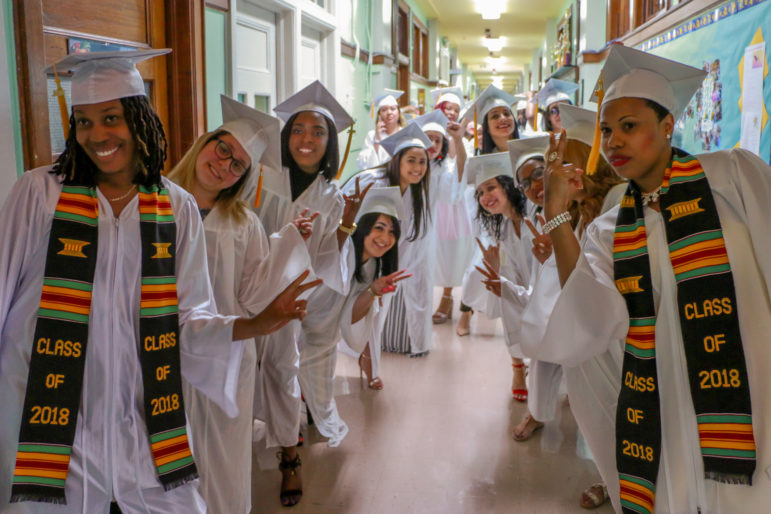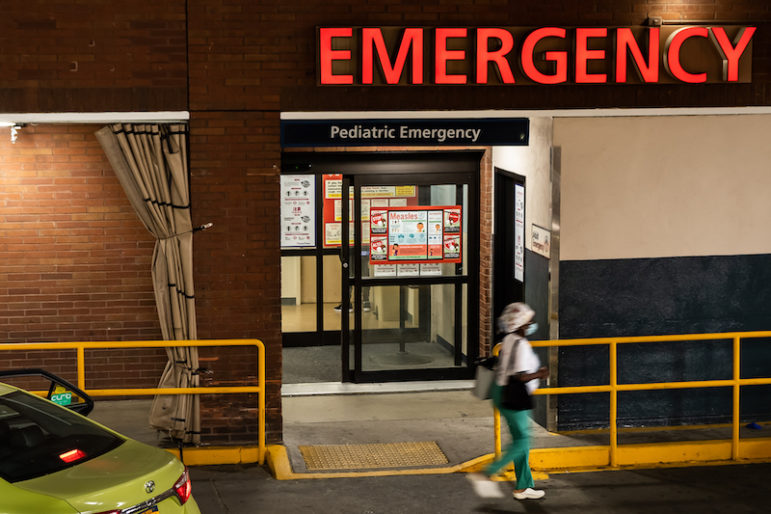
Grace Outreach
A graduation ceremony for women who completed a program operated by Grace Outreach.
When someone says: “a New York Woman” what immediately comes to mind?
Do we call up the image of someone fashionable, successful, powerful—and well-heeled? Picture one the small elite group of fictional or non-fictional New York females—publishing moguls, heads of fashion houses, stars of Saturday Night Live…President’s daughters—who know how to make themselves seen and heard?
Or do we summon up one of the more than three million girls and women from communities of color and immigrant communities who comprise the overwhelming majority of New York’s female-identified residents—and on whose collective shoulders the overall wellbeing of the city rests?
In 2013, The New York Women’s Foundation decided to produce a series of “Voices from the Field” reports exploring the roles and circumstances of NYC women at four major stages of their lives—i.e., ages 0-8, 9-24; 25-59; and 60+. And—true to The Foundation’s primary focus on issues of equity and justice—it opted to concentrate on the girls and women whose opportunities for progress are most constricted by societal attitudes about race, background, sexual orientation, gender identity and class.
The four-part series is now complete and available for review. And what it illuminates about this pivotal cohort of girls and women is eye-opening, compelling and consistent across all four age groups.
The experts whose spoke about the city’s youngest girls of color invariably described them as spunky and determined, caring and compassionate. The ones who focused on the teens stressed that they do better in school than their male peers; perform the behind-the-scenes housekeeping, baby-sitting and wage-earning functions without which their families could not survive; and are invariably the first to lead projects benefiting their communities.
The leaders who discussed women of color and immigrant women in their “prime” working years recounted that they maintain substantially higher workforce participation rates than almost any other group of New Yorkers. That they are both the primary caregivers and the primary providers in their families a clear majority of the time. That their labors singlehandedly sustain the city’s cornerstone retail, service and manufacturing industries. That their role as New York’s principal nannies and maids and home health aides is what enables so many other women to work.
In a similar fashion, the interviews related to older women revealed that they increasingly remain employed significantly past what used to be considered “retirement age.” That they are singlehandedly raising a full 100,000 of the city’s children. That they furnish the critical, free daily childcare and housekeeping services that enable tens of thousands of their adult children to manage their jobs.
The information garnered for the four reports also offers incontrovertible evidence that all the hard paid and unpaid labors of New York’s women of color and immigrant women across all the years of their lives provides no guarantee of economic security, safety or societal power and voice.
On the contrary.
It underlines the fact that girls and women of color and immigrant women constitute the least economically-secure population in the city. That they are at the highest risk for violence and abuse—public and private, sexual, physical and financial—from their earliest childhoods through their oldest years. And that they are the least likely to be noticed and supported through public policies, philanthropic priorities or nonprofit practice.
Women of color and immigrant women earn consistently and significantly less than do White men—and White women—even when they fill the same exact jobs. Latina women earn 46 cents for every dollar earned by White men, Black women earn 55 cents, Asian women earn 63 cents and White women earn 84 cents. And so—unsurprisingly—fully 86 percent of the many households solely supported by a Latina woman are unable to cover basic monthly expenses on a regular basis, as are 76 percent of those that are dependent on a Black woman and 75 percent of those that are dependent on an Asian woman.
Get the best of City Limits news in your inbox.
Select any of our free weekly newsletters and stay informed on the latest policy-focused, independent news.
Thousands of girls of all ages are in the custody of the city’s child welfare system for reasons of neglect and abuse. The overwhelming majority of the 270,000 calls to NYC’s Domestic Violence Hotline are from women of color. An estimated 135,000 older women—most of them older women of color—experience regular physical, emotional or financial abuse from those who depend on them—or on whom they depend. Black women are harassed by the police as often as their male counterparts. One in five trans women of color reports experiencing police abuse. Hate crimes against immigrant women in general and Muslim women in particular are on a precipitous rise.
The philanthropic sector channels less than 7 percent of its resources specifically toward supporting girls and young women. And when the public sector policies rarely are shaped by the concerns and specific situations and preferences of the female population. Youth development programs typically leave girls on the sidelines while boys take primary possession of the basketball courts, the snacks and the attention of staff members. Job training programs omit the stipends without which primary wage-earning women cannot participate. Alone among almost all industrialized countries, the U.S. fails to provide universal subsidized child care.
The picture is not unremittingly grim. The Foundation’s four “Voices from the Field” reports also document the efforts of a host of far-sighted grass-roots organizations in support of women’s progress. Youth programs enabling low-income girls of color to excel at academic, athletic and artistic endeavors. Advocacy efforts fighting for better wages and working conditions. Programs assisting grandmothers raising grandchildren. Violence prevention initiatives offering viable permanent housing options to those who are fleeing batterers.
But those programs invariably have only limited reach and the public and philanthropic sectors remain minimally engaged in accelerating their work—or following their lead.
It is clearly time to do better. To pay better attention. To invest with more radical generosity into the wellbeing of the bold, strong, responsible, resilient girls and women who represent the backbone of our families, communities and economy—and the future of our city.
Ana Oliveira is the President and CEO of The New York Women’s Foundation. The Foundation has advanced a dynamic philanthropic strategy based on the fundamental reality that, when women thrive, their families and communities also thrive. Its grantmaking places it at the top of public women’s foundations in the United States, and in the top two in the world.








